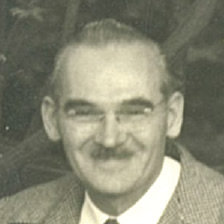Even in their earliest form, Hart’s teaching approaches attracted a following. Three especially promising young writers—Robert Horan, Jeanne McGahey and Rosalie Moore—arrived in one of his classes at almost the same moment in 1937. Catching fire from Hart and from each other, they progressed rapidly and began to regard themselves as a group.
Hart began corresponding with editors across the United States, calling their attention to a literary phenomenon from a region they thought of as a backwater. Gradually acceptances came, in tandem and individually. Jeanne McGahey (about to become Hart’s wife) appeared in the New Directions anthology Five Young American Poets (1942). Robert Horan, then living in New York, was selected by W. H. Auden for the Yale Series of Younger Poets (A Beginning, 1949). Rosalie Moore followed in the series in 1951 (The Grasshopper’s Man and Other Poems).
The word “Activist”—not intended to have any political connotation—first appears in the group’s 1946 publication “Ideas of Order in Experimental Poetry.” After W. H. Auden used it in introducing The Grasshopper’s Man, “Activist” became a fixture. Poetry magazine devoted its Spring 1951 issue to the Activists; a half-issue sequel would follow in 1958.
New writers meanwhile were coming into the circle. Notable in the 1950s were Robert Barlow, Robert Brotherson, Marie Graybeal, Leonard Horwitz, Adele Levi, Lois Moyles, Fred Ostrander, Emily Pausch, Betty Turnoy, Marie Wells, Don Wobber, and George T. Wright. From 1950 to 1955, the group published the magazine Number, edited by Brotherson and Wobber.
In 1958, as the second Poetry feature went to press, Hart and some of his colleagues took to the columns of the San Francisco Chronicle to criticize a transplanted poetic movement that was taking center stage in the region: the Beat Generation, stars of what was billed as the San Francisco Renaissance. Though the Beats presented themselves as daring radicals, Hart saw them as reactionaries, leading the charge backward from Modernist-level savvy and inventiveness. Letters flew. The file is fascinating reading—reminder of a time when a good fight about poetry could reach the Sunday papers.
No doubt who “won.” In fact, all non-Beat literary efforts in the San Francisco region were at least temporarily eclipsed. And the Beat excitement in San Francisco, like the New York School on the other coast, presaged a wider shift of American poetic taste. Looking back later, Hart saw 1958 as the end point of the Modernist era in poetry. That era had begun, he said, with the publication of Baudelaire’s Les Fleurs du Mal in 1858—and closed precisely a century later with the publication of Allen Ginsberg’s Howl.
For the rest of the century, the Activist label was no longer useful in marketing. Despite some prestigious individual publications later on, especially by McGahey and Moore, the Activist group as such disappeared from the literary radar screen.
What continued undeterred, however, was Hart’s freelance teaching and research, in schools and colleges up and down the Bay Area as well as in private seminars. He kept on refining his theory and method, demanding still more originality, still more precision, still more force; and a certain number of people always found their way into his underpublicized classes and worked there, sometimes for many years. Among the notable later members of this circle have been John Hart, Patricia Nelson, Laurel Trivelpiece, and Judith Yamamoto. Until his death in 2016, Fred Ostrander, active in the group since the 1950s, was a link to the early days.
